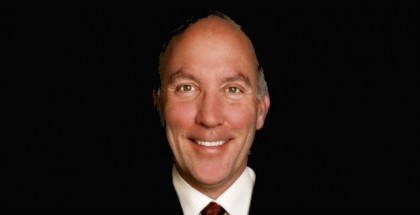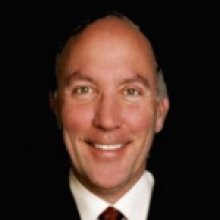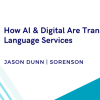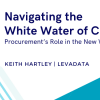Chip Wagner is the CEO of Alsbridge, one of the world’s leading sourcing advisory organisations. At a time of significant challenges for advisory firms the world over, Alsbridge is enjoying a purple patch with very healthy growth being reflected in a wave of expansion and key acquisitions. Outsource’s editor Jamie Liddell got together with Chip to discuss the advisory landscape and Alsbridge’s growing prominence within it – and to get the inside track on some very interesting recent developments within his organisation…
Outsource: Thanks for taking the time today to share some of your thoughts with Outsource’s readers, Chip. Let’s start by taking a look at some of the main developments that are shaping the industry right now. We’re well into 2016: what are some of the key trends that will be dominating the rest of this year?
Chip Wagner: Well, I think there are a couple of things, Jamie. I spent some time yesterday with the CEO of CSC, Mike Lowry. He talked about the rebirth of the non-government side of CSC and the digital transformation that he’s trying to take his customers through, on both the infrastructure side in terms of cloud-based capabilities, and on the application side with various modernisation efforts. And while it’s leading to the cannibalisation of existing revenue streams, from his perspective that will hopefully lead to the reinvestment of those dramatic savings, in ways that build a partnership between CSC and their enterprise customers. He seems to be on a nice course of reinventing CSC.
That’s happening everywhere of course, as people are looking at changing old outsourcing contracts and even ones that, over the last five years, weren’t taking advantage of the increasingly commoditised infrastructure environment. I would say another very major transition upon us now is robotic process automation or autonomics or cognitive computing. It’s known as a lot of different things but regardless of the name it is going to be a major inflection in the cost structure of outsourcing on both the BPO and the ITO side, and will change existing service provider relationships dramatically.
O: Do you think that’s happening at pace yet? Because it’s been bubbling under for a while, it’s been the big thing for a year or so, but are we seeing any large implementations where we can genuinely say we’ve reached a tipping point on this?
CW: Oh, definitely not the tipping point. We’re still in the early days. In fact, I liken it to the cloud process that took place 10 years ago. There was a lot of hype, a lot of discussion, a lot of early promise articles, lots of marketing stimulation – and then it became the reality, and now of course it’s at scale in a major way globally, with completely new players that have come in to contend in a space that was not even present a decade ago. With RPA, I think we’re seeing a lot of trials, a lot of people sticking their toes in the water, some proofs of concept, small processes being automated. And then as people see results and see that it is in fact as easy as it is professed to be, I think we’ll start to see scale this year and in 2017. But this is something that’s in the early stages of what will be, to my mind, revolutionary.
O: And how is that impacting at this stage on the kind of work that you’re doing? Clearly this is a new field; there is very limited expertise compared to the more traditional outsourcing, so what does that mean in terms of how you’re working with clients? What’s expected of you? From an advisory perspective, what’s the impact?
CW: Well it’s had a couple of different impacts. Often we’re asked simply to come in and help people assess what can automation and robotics do for them in given processes, be they BPO candidates or IPO candidates. The robotics can address existing retained organisations around an existing supplier, so they can look to automate functions that are not part of scope for existing IPO or BPO deals.
Conversely, if they haven’t outsourced something or if they haven’t created a shared service model or looked to offshore then they can consider automating functions in place – perhaps obviating the need, then, to take a further look at shared service or outsourcing. In some ways it can be seen by an anti-outsourcing person as an antidote against the need to outsource, or to send work offshore or to create a shared service centre. The other thing that it’s meant is that we need to be sure we take a look at the effect of automation as we are doing outsource assessments for clients, because it is an all-new variable that does change the economic equation of what is the art of the possible.
O: Just going back to something that you mentioned about shared services: increasingly, when you have organisations looking at global business services for example, it’s not necessarily an either/or binary equation now. It’s not necessarily just outsourcing or insourcing; it tends to be a mix of both, certainly at the larger end. How does robotics figure in that, because it seems like robotics may well be an alternative to a lot of traditional service delivery options – but surely it’s going to be needing that shared services environment anyway within which to place a robotics solution?
CW: I think shared solutions on a global basis and even on a domestic basis in any given country are hybrid equations. They’re in-house-offshore-captive. But I think robotics is the variable which tips the scale, perhaps, away from putting a lot of the work offshore. I think if you automate things properly up front then it changes the mix of what is potentially going to go to a GBS.
O: Looking at it from the service providers’ perspective: do you feel that the major providers we’ve known and loved and worked with for the past 10, 15, 20 years have a handle on this yet? A lot of people have invested a lot of money into robotic solutions but at the moment clearly, as you see it, it hasn’t reached a tipping point yet, and I’m sure there is an increasing amount of panic in the marketplace right now. How do you feel the service provider community is viewing this, and are they on top of it as they need to be?
CW: There’s quite a bit of difference in the way that people have looked at it. We’re all very familiar with the very substantial investment that IBM made in Watson, that was kind of the super computer, the giant cognitive computing capability, and frankly it’s a phenomenal piece of technology that someday may go as far as something like curing cancer when enough information is finally put behind that much computer power.
When we go downstream, on one end of the spectrum we have lots of new software providers that are building solutions, such as Blue Prism and Arago, and as we then come upstream from the single software providers into the Indian and American and international providers of IPO and BPO services, some of them are building their own: Wipro has built HOLMES, Ignio has been built by TCS, and we can keep on going down the line. Others have chosen to take a systems integration route, using open source and some custom development to weave together the existing commercial off-the-shelf software that’s out there plus their own work. I think everyone’s looking at it because if they don’t look at it they’re going to be more threatened by it.
How it’s manifested itself is similar to what Mike Lowry was discussing yesterday with me, with regards to the digital transformation of his infrastructure contracts from the traditional legacy ITO deals into cloud-enabled, much less expensive, more commodity styled, Infrastructure-as-a-Service type arrangements. I think we’re going to see the same thing: if you have major BPO arrangements, or major ITO arrangements, they usually have price productivity curves in them anyway, and they’re probably now going to have robotics curves put into them, in such a way that providers will be obligated to design new contracts that bring automation to the deal as a matter of table stakes.
So the smart thing to do if you’re a provider is to really approach your clients well before the contracts are up and offer to bring the technology and the automation forward now, even if it means cannibalising your revenue – because it might mean saving your contract.
O: And are you feeling that there is genuinely a lot of this being demanded by the buyers? It seemed like a few years back when cloud was the next big thing, and a lot of service provision was being moved over to the cloud, buyers were going to the vendors and saying “Look, we know that this is a cheaper solution to deliver, so why are you still billing us at the old rates? We want to be saving money right from the start here!” – which was a bit blind to the upfront investment that the vendors had to make originally. Is the same kind of thing happening here with robotics? Do you think buyers are demanding cheaper, more effective, more efficient solutions without necessarily thinking about the money that’s had to be poured in at the start?
CW: Well this will go from a whisper to a scream, in the same way that it did on the cloud. There’s going to be the CFOs and CEOs as they travel around, reading various periodicals that their peers send them. They’re going to see these outrageous claims for huge amounts of planned improvement, dramatic cost reductions, and they will begin to put pressure on the internal CIO and CTO community – and for that matter on the other operating executives, since these aren’t necessarily pure technology plays. And then I think that, yes, the providers will have that demanded of them – and in fact given that many of these tools are off-the-shelf software, there isn’t a huge investment by an ITO or BPO provider necessary to enable the use this type of automation in their delivery. Which can then manifest itself into dramatically less expensive services for their customers – and it’s going to be demanded of them, and this is why I think this is as large an inflection point as the entire subject of cloud was to infrastructure: what that was, this will be to labour.
O: Let’s take a step back and take a look at what’s going on with Alsbridge internally, then. You’ve had a couple of quite big announcements over the past few weeks in terms of moves and promotions: can you give our readers a bit of insight into that?
CW: Well we’ve really had a nice three-year run and the growth we’ve enjoyed has put us in a position where lines of control had become somewhat untenable, and the numbers were so large that we weren’t really adequately caring for and feeding our own people internally to make sure they were supported by the entity that is our firm. So we’ve structured slightly differently. We’ve asked Jeff Seabloom to assume the chief revenue officer role for our North America operations, so he’ll be responsible for all of our market-facing MDs in North America – and those people had originally reported to me, so that will allow me to do some things that are important for us as we look at this next segment of growth.
There are always inflection points in companies; you get to a certain size and the model you were working under is no longer appropriate for the size and scale that you’ve reached, and we’re just humbled and privileged and honoured to be in a position where we are enjoying growth. We have great support from our clients and we have phenomenal talent inside the firm which is capable of taking on more responsibility and leading us to that next level of performance.
As another aspect of this global push, we’ve asked Laura Mersinger to take on the chief marketing officer role of the firm, which is an expansion of her previous responsibilities, and again we’re very excited about everything that Laura brings forward: she’s been a phenomenal addition, one of the best hires we’ve had in the last five years. We’re very bullish on what both Laura and Jeff will do in their new capacities.
O: What’s the connection between that and the acquisition last year (April 2015), of Source and the expansion over here in the UK and Europe? How’s that been going – and how has that affected the moves that you’ve made recently.
CW: It’s been going great, and we couldn’t be happier about having Source join us. We’re thrilled with the acquisition and the addition of Source and the great team that Barry and Eleanor brought to the table, and to have a stronger presence in northern Europe – and I think you’ll see us starting to look at other opportunities and other geographies that may present some more opportunities. In these particular moves, Laura’s global chief marketing officer role will continue to work very closely with both US and global opportunities, so she’s very active with the former Source team and our UK guys. With regard to Jeff Seabloom and his role, he’s North American-centric, for the time being at least, so that won’t have a particularly direct impact on our operations in the UK.
To read the second part of this interview, click here.
Editor’s note: Alsbridge is a client of both Outsource (as an Inner Circle oNexus partner) and Sourcing Industry Group (SIG), Outsource’s parent company. However, this interview was not conducted as part of any commercial agreement, and the editor has retained full control of the content. For more information on this – or any other aspect of Outsource’s editorial approach – please send your queries through to the editor at jliddell@sig.org.






